 |
by Lawrence Bonk on (#70T4G)
EA employees involved with the Communications Workers of America union have issued a sternly-worded statement against the recently-proposed private acquisition of the company by Saudi-backed investors, according to a report by Eurogamer. The complaints don't involve Saudi Arabia's long history of human rights violations, but rather that workers weren't represented in any negotiations for the $55 billion deal.The employees worry that any jobs lost as a result of the purchase would "be a choice, not a necessity, made to pad investors' pockets." In addition to this formal response, unionized workers have issued a petition that urges regulators to scrutinize the deal.
|
 Engadget is a web magazine with obsessive daily coverage of everything new in gadgets and consumer electronics
Engadget is a web magazine with obsessive daily coverage of everything new in gadgets and consumer electronics
| Link | https://www.engadget.com/ |
| Feed | https://www.engadget.com/rss.xml |
| Copyright | copyright Yahoo 2025 |
| Updated | 2025-12-24 02:32 |
 |
by Andre Revilla on (#70T4H)
The FCC is moving to expel Hong Kong Telecom (HKT) from US telecom networks, citing national security concerns. The agency sent HKT an "Order to Show Cause," which directs the company to explain why the FCC should not begin revocation proceedings against it.The 30-page order outlines the agency's reasoning, including a focus on applying new certification and disclosure requirements to entities "owned by, controlled by or subject to the jurisdiction or direction of a foreign adversary."Today's Order continues the FCC's work of ensuring that CCP-controlled entities that pose national security risks to our country cannot connect to our telecom networks," said FCC Chairman Brendan Carr in a statement announcing the move. HKT is one of the largest telecommunications companies in Hong Kong and is a subsidiary of communications giant PCCW. Roughly 18 percent of PCCW is owned by China Unicom, a state-owned telecommunications company.HKT is not the only target of the agency's ongoing effort to root out potential vulnerabilities. On October 28, the FCC will be voting on steps to further strengthen guardrails under its equipment authorization program to protect US networks and the communications supply chain against national security threats.The past month has seen ramped-up regulatory activity from both China and the United States aimed at companies that operate in or generate revenues from one another's markets. Chinese regulators have been investigating large tech acquisitions, telling local companies not to buy American AI chips and tightening export controls on rare earth minerals. Much of this comes against the backdrop of trade negotiations between the two countries.This article originally appeared on Engadget at https://www.engadget.com/general/the-fcc-wants-to-expel-one-of-hong-kongs-biggest-telecom-operators-from-us-networks-155204605.html?src=rss
|
 |
on (#70T0R)
It's been quite a while since we've heard much about Quantic Dream's Star Wars: Eclipse. The studio revealed that project at The Game Awards back in 2021 and details have been scarce since then. As it turns out, the developer of Heavy Rain and Detroit: Become Human had been working on a second game this whole time. It's one that sees Quantic Dream venturing into entirely new territory, because the studio is making its first multiplayer game.Spellcasters Chronicles is a 3 vs. 3 MOBA with a third-person perspective that's akin to Marvel Rivals. Each round lasts 25 minutes, with teams summoning minions, battling to conquer territory and earning victory by destroying their opponents' lifestones. So far, so typical MOBA. But Quantic Dream has a few tricks up its sleeve that it hopes will help make Spellcasters Chronicles stand out in a highly competitive live-service market.It's a magic-based MOBA with characters that have unique abilities, personalities and backstories. Every one of these mages has the ability to fly at any time and for as long as they want. So you can freely take to the skies to get a bird's eye view of the battlefield and help you make decisions about what to do next. You can duke it out with enemies in the air too.Along with attacks, support spells and summoning armies with hundreds of creatures, players can use their magic to plunk down buildings and shore up their defenses while altering the environment. There's interplay between characters too, as you can infuse allies (including summoned creatures) with spells. One mage, for instance, might add fire to a tankier teammate's hammer, so there are synergies to discover. "Something we wanted to push is the sense of creativity," game director Greg Diaconu told reporters ahead of the reveal.Spellcasters ChroniclesQuantic DreamEventually, you'll be able to bring giant, game-changing titans into battles. Each player can summon one. Whenever a titan appears, it's an all-hands-on-deck situation for the opposing team, since these are powerful creatures that can completely change the course of a round."It was important for us to create a sense of spectacle," Diaconu said. "Something that's as fun to watch as it is to play."It all seems quite action-packed, but there's a heavy strategic element to Spellcasters Chronicles as well. Before you go into a battle, you'll select your spells and summons, including your titan - so this is a deckbuilder game too. In the thick of the action, your team will need to decide when to pressure the map and try to expand your territory while capturing altars of power, totems that will grant you resources. Speaking of which, each spell has a limited number of uses, so resource management is a factor too.Spellcasters Chronicles is free-to-play, but there are no pay-to-win concerns here. In-game purchases will be purely cosmetic. Expect battle passes full of new looks for the characters. Lots of updates are in the pipeline too, including new mages, spells and creatures.Seven years in the ovenQuantic Dream started making Spellcasters Chronicles seven years ago (so before Netease bought a stake of the company and eventually the whole shebang). Although the studio decided to keep making narrative-driven single-player games after Detroit: Become Human, it wanted to try something new as well. The idea was to take the team's experience of working on interactive storytelling to a different genre by creating a multiplayer game with a stylized look."Multiple teams are fully dedicated to crafting the next generation of great games, including something very different, a competitive multiplayer experience, born from the same spirit of curiosity and creativity that has always defined us," Quantic Dream founder David Cage wrote in a blog post on Thursday. "This new title may surprise our fans as it is very different from what we have done so far. But taking risks, challenging ourselves, exploring new ways of playing and telling stories, and attempting what seems impossible, has always been part of our DNA."In the world of Spellcasters Chronicles, gods are no more and mages who are able to harness an energy called the Source will shape the future. Quantic Dream hasn't shared too many details about the plot and characters of Spellcasters Chronicles just yet - the reveal focused on gameplay. That's perhaps in part because the studio is leaning into a community-driven narrative approach. Victories and defeats will contribute "to the evolving Tapestry of Fate, where seasonal decisions will change gameplay, lore and map meta."We shouldn't have to wait too long to see how all of that works in practice. Quantic Dream will run a closed beta for Spellcasters Chronicles on Steam later this year, and the game is set to hit consoles with cross-play support in 2026. Those who are attending TwitchCon San Diego this week can try out the MOBA there.This article originally appeared on Engadget at https://www.engadget.com/gaming/for-its-next-trick-quantic-dream-is-trying-to-compete-with-league-of-legends-and-dota-150000283.html?src=rss
|
 |
by Matt Tate on (#70T0S)
Buried in the press release for the upgraded Vision Pro headset that Apple announced yesterday was the news that the dedicated Apple Vision Pro app is making its way to iPad via iPadOS 26.1 later this fall. This means iPad users can browse Vision Pro content like apps and games from their tablet and queue downloads for the headset without needing to put it on each time.The Vision Pro app has been available on iPhone since the arrival of iOS 18.4 in April, and features a regularly updated selection of curated spatial content that Apple thinks Vision Pro users might want to try. Open it up today, for example, and it'll point you towards the Lungy app's audiovisual meditations, the travel show Elevated on (the recently and very confusingly rebranded) Apple TV, some recommended games and a list of education-focused apps available on Vision Pro. The Vision Pro app also includes news and tips for using the headset, as well product information and account settings. All of the same features will be offered in the iPad version of the app.In case you missed yesterday's announcement, Apple has introduced an improved Vision Pro headset powered by the same M5 chip housed in its new iPad Pro and MacBook Pro. This should represent a fairly significant jump up from the first-gen product's M2 chip. Web-browsing will be faster, as will loading apps and just generally navigating menus on your headset.The M5 chip also features a new 10-core GPU, which should significantly boost gaming performance, and without handing us any battery specs (which the company never likes to do), Apple says the upgraded Vision Pro should last a bit longer too. The M5 Vision Pro is now ready to pre-order now and still costs $3,499. Apple will start shipping the device on October 22.This article originally appeared on Engadget at https://www.engadget.com/apps/the-vision-pro-will-get-an-ipad-app-in-upcoming-ipados-update-142904090.html?src=rss
|
 |
by Mariella Moon on (#70T0T)
Ever since since 2018, the United States Mint has issued special $1 coins every year to honor American innovation and the "pioneering efforts of individuals or groups." The Mint has just revealed the designs for 2026 $1 Innovation coins, and one of them features Apple co-founder and former CEO Steve Jobs. It features a young Jobs sitting cross-legged in front of a quintessential California landscape with rolling hills and oak trees. "His posture and expression, as he is captured in a moment of reflection, show how this environment inspired his vision to transform complex technology into something as intuitive and organic as nature itself," the announcement reads.Under the project, the US Mint showcases innovations and innovators from different states, the District of Columbia and the five US territories. It works with the governor and other officials of each state or region to determine the best design to represent the people and inventions being featured. Jobs, of course, represents California, where he was born and from where he ran Apple, which became one of the biggest companies in the world under his leadership.In addition to Jobs' design, the Mint is also issuing $1 coins featuring Iowa's Dr. Norman Borlaug, who led initiatives to develop more resilient crops, and an aerial view of the Cray-1 supercomputer in Wisconsin. Finally, the design honoring mobile refrigeration, which represents Minnesota, features a 1940s-era truck with an early front-mounted refrigeration unit.This article originally appeared on Engadget at https://www.engadget.com/big-tech/the-us-mint-is-honoring-steve-jobs-by-putting-him-on-a-1-innovation-coin-130033801.html?src=rss
|
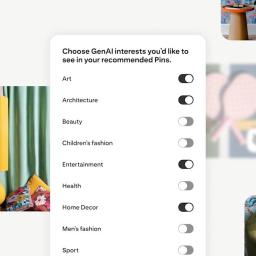 |
on (#70T0W)
Pinterest is taking new steps to reduce the amount of AI slop its users are seeing. The service is adding settings that allow people to "dial down" AI-generated content in a number of categories that are "highly-prone" to such imagery, the company said in an update.While most social platforms have grappled with how to deal with the rise of AI-created content, Pinterest has been particularly inundated. Its image-board UI has proven particularly susceptible to AI slop, and users have complained about the difficulty of finding content created by humans.Now, Pinterest is offering users more control over how much AI content appears in their recommendations. The service is adding a "refine your recommendations" setting that allows you to toggle generative AI content from specific categories, including art, architecture, beauty, fashion, entertainment, health, home decor and sport. According to the company, these topics have seen an influx of AI-generated content, but users should "expect even more additions in the future."Notably, Pinterest isn't promising to root out generative AI content entirely. Rather, it says the new settings should "dial down" the amount of AI-based content they're seeing in a particular category. A spokesperson for the company says this is because not all AI-generated content on the platform is low quality and some users are in fact open to seeing AI-generated material.The setting also applies only to image pins, not video, so it likely won't do much to prevent Sora or other AI-created video clips from appearing in your feeds. For AI-created or AI-edited content that does continue to surface, Pinterest says it will label these posts more prominently. The company started experimenting with labels back in May, but has now "ramped up" its tools for identifying such content.Pinterest's new settings are available now on desktop and Android and will be available on iOS in the next few weeks.
|
 |
on (#70T0V)
Over a decade since Microsoft tried to make talking to Cortana on PCs a thing -- and spectacularly failed in the process -- the Windows giant is taking another swing at voice commands with its Copilot AI assistant in Windows 11. Starting today, the company is rolling out an upgrade to its existing Copilot Voice and Vision features which will let you say "Hey, Copilot" and then ask your PC a question based on what's on the screen. If you're looking at pictures of Hawaii, for example, you could ask your Windows 11 PC where exactly they were taken, have it plot you a flight plan and potentially even give you some budgeting tips to afford that island vacation.Microsoft's jaunty promotional videos for the Copilot features, set to Vampire Weekend's almost two-decade-old "A Punk," make the process look practically seamless. One user asks Copilot to show them how to stream their music in the "best possible quality," and the AI proceeds to highlight the exact location of the streaming settings in Spotify, while suggesting they choose the lossless option. Another person asks Copilot to write up a short biography based on their photo portfolio. Now Copilot isn't just about searching the web or generating novelty AI art, it's making it easy for users to perform practical tasks without much effort.Microsoft is clearly striving for the convenience of the Star Trek ship computer, a dream that also pushed Amazon to invest billions in its Echo devices and Alexa. The difference with Copilot is that you're not just talking to a faceless speaker -- Microsoft is also trying to make Windows 11 aware of what you're doing on your screen. The "Hey Copilot" feature and all of the Copilot Vision are cloud-based, so you'll have to live with image data of your desktop making its way to Microsoft's servers. That involves a level of trust the company has lost with many users, especially after the messy debut of Recall, its first flagship AI-powered feature.It doesn't help that many people are still peeved about the death of Windows 10 support this week. Unsurprisingly, the company stresses that "Hey, Copilot" is a purely opt-in feature that's buried in the Copilot app settings. (Of course, that can always change, especially if the company wants to juice AI engagement stats in a few years.)Copilot ActionsMicrosoftI suspect it'll be even harder for users to swallow where Microsoft wants to take Copilot: Giving it the ability to perform Windows tasks on its own. That's the goal of the experimental Copilot Actions feature, which initially debuted as a tool that could perform tasks on websites. Once enabled, Copilot Actions can be prompted to handle manual tasks, like resizing and straightening an a folder of photos. If any questions pop up, it can prompt you to answer them within the Copilot app. And as Copilot Actions is handling its job in the background, you're free to do anything else you'd like on your computer.Conceptually, Copilot Actions sounds similar to handing off a task to a real life assistant -- but just like a human assistant, there's always a chance something could go wrong along the way. It's also not hard to imagine the feature being coopted by nefarious malware down the line, since it's basically a Windows script in a better interface. Microsoft says it's tested Copilot Actions "extensively" internally, and it's rolling out the feature slowly to gather feedback.Just like "Hey, Copilot," it's entirely opt-in, and you can see everything Copilot Actions is doing step-by-step in the Copilot app. Microsoft says you'l be able to jump in and take control of a Copilot Action job at any point, as well as control the permissions of AI agents in Windows 11's user settings. Copilot tasks are also performed in a contained environment, according to Microsoft, which allows for even more specific permissions controls as well as runtime isolation (so Copilot can't affect the rest of your system beyond its specific task).And as if we're not already inundated with Copilot all over Windows 11 already, Microsoft also plans to add an "Ask Copilot" search function right on Windows 11's taskbar. The company claims it's part of a mission to make the taskbar "a dynamic hub" for accomplishing tasks, but personally I like to keep my taskbar clear so I can cram in more app windows. Like everything Microsoft is announcing today, the Ask Copilot bar will also be entirely opt-in.As someone who's been skeptical of Microsoft's Copilot initiatives so far, I could actually see myself using Hey Copilot" if it works as advertised. It sounds far more practical than the old Siri voice commands, which were limited by simplistic language models from a decade ago. Microsoft is also expanding AI actions built into Windows 11, including a new integration with Manus, an AI agent that can do things like turn several documents into a website, as well as Filmora, which lets you create AI videos right from the File Explorer.The new "Hey Copilot" and Copilot Vision features are available today on all Windows 11 PCs that have access to Copilot. Microsoft is also making Copilot Vision broadly available around the world today where Copilot is available. Copilot Actions and the Ask Copilot taskbar feature will "gradually" become available to Windows 11 Insiders, according to Microsoft.This article originally appeared on Engadget at https://www.engadget.com/computing/microsofts-next-windows-11-ai-gamble-just-say-hey-copilot-130000875.html?src=rss
|
 |
by Sam Chapman on (#70T0X)
ExpressVPN is one of the best VPNs on the market, with user-friendly apps, excellent speed test scores and a strong security record. In my ExpressVPN review, I found it to live up to its positive word of mouth, especially when unblocking foreign streaming sites. But no service is perfect, and my cup of VPN tea is not everybody's. If you're looking to switch away, follow this guide to cancel ExpressVPN.How to cancel ExpressVPN on desktopNo matter where you originally signed up for ExpressVPN, you can cancel through your browser on a desktop platform. With any browser (i.e. Chrome, Safari, etc), the steps are as follows. Note that doing this will instantly cancel your ExpressVPN subscription and revoke your access to the service.
|
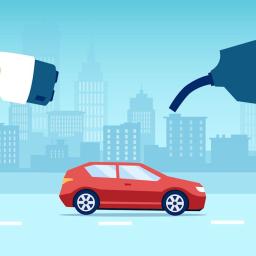 |
by Mariella Moon on (#70SVE)
The difference in emissions between plug-in hybrid electric vehicles (PHEVs) and gas cars is merely 19 percent and not 75 percent as lab tests show, according to a report by a group of European transport and environment NGOs. They analyzed data transmitted by the onboard fuel consumption meters of 800,000 plug-in hybrids registered in the continent between 2021 and 2023. What they found was that the real-world carbon dioxide emissions of PHEVs were 4.9 times higher than what they're supposed to emit on paper, mostly because of manufacturers' and testers' flawed assumption on the share of the vehicles' electric driving mode.Specifically, the official estimates for the share of electric driving mode are 84 percent, but the share is only as little as 27 percent in the real world. That means most of the driving done on PHEVs uses gas. In addition, even when PHEVs are in electric driving mode, they're still emitting considerable pollution. Apparently, their electric motors don't have sufficient power to operate on their own, and their combustion engines have to supply power for almost a third of the distance driven. The lack of fast charging in PHEVs also makes it less convenient to charge, leading people to just fill their tanks with gas. All these factors don't only translate to pollution, but also to additional gas expenses. The report says drivers end up paying $582 more than official estimates for fuel costs.As The Guardian notes, carmakers have been pushing for the adoption of PHEVs in Europe as a low-emissions alternative that won't give owners range anxiety, with Volkswagen, Mercedes-Benz and BMW accounting for most of the sales over the past years. The researchers have noted that four major carmaker groups have avoided over $5.8 billion in fines between 2021 and 2023 due to the underestimation of PHEV emissions in the lab. These official emission numbers allowed companies to comply with the required carbon dioxide emission targets for their fleets. Based on real-world data, however, the vehicles they sold emitted 52 million tons more carbon dioxide than they were supposed to.This article originally appeared on Engadget at https://www.engadget.com/transportation/plug-in-hybrids-emit-almost-as-much-pollution-as-gas-cars-report-finds-120032534.html?src=rss
|
 |
on (#70SJ0)
In an embarrassing error, PayPal blockchain partner Paxos accidentally minted 300 trillion of the PYUSD token today. PayPal's stablecoin, which it debuted in 2023, is supposed to be redeemable at a 1:1 rate for US dollars. $300 trillion is more than double the entire world's current GDP of $117 trillion. In short, that's a really bad mistake from Paxos.At least the action did appear to be a mistake. Paxos acknowledged the issue in a post on X, assuring clients that their funds are secure and stating that it burned the excess reserves of stablecoins. The company claimed that "this was an internal technical error." Maybe so, but internal technical errors can still wreak havoc pretty quickly when it comes to finance, especially in the fantasy worlds of blockchain and crypto. Thanks to the appropriately named Web3 is Going Just Great for picking up on this story.This article originally appeared on Engadget at https://www.engadget.com/cybersecurity/paypals-blockchain-partner-accidentally-minted-300-trillion-in-stablecoins-224017538.html?src=rss
|
on (#70SJ1)
Google has released a new update to its Veo AI video generation model that should make it do a better job of sticking to prompts and converting images into videos. Veo 3.1 is available to try today through Google's Gemini API and is now also powering the company's Flow video editor.Veo 3.1 builds on the new capabilities Google introduced with launch of Veo 3 at Google I/O 2025. The new model offers better "prompt adherence," according to Google, and should have an easier time creating videos based on the image "ingredients" you upload alongside your written prompt. Veo 3.1 also makes it possible to convert images to video and generate audio at the same time, a capability that wasn't available with Veo 3.In Flow, Veo 3.1 supports at least a new feature that gives you finer control over the videos you generate. With what Google calls "Frame to Video," Flow lets you upload a first and last frame, and then generates the video in-between. Adobe Firefly, which is powered by Veo 3, offers a similar feature, but Flow will be able to pull it off and create audio at the same time. Those added audio skills will also apply to the video editor's ability to extend clips and insert objects into existing footage, too.Based on the samples Google's shared, videos generated with Veo 3.1 still have an uncanny quality that seems to vary greatly depending on the prompt and subject. Even if it's missing some of the realism of OpenAI's Sora 2, though, the company's decision to try and make Veo more useful to people who actually work with video rather than a source of social media spam is a welcome move.This article originally appeared on Engadget at https://www.engadget.com/ai/googles-veo-31-is-better-at-generating-videos-from-images-220829129.html?src=rss
 |
on (#70SFT)
Heads up, indie game fans: 1000xResist will arrive on Xbox Series X/S and PlayStation 5 on November 4. The title, which is already out for PC and Nintendo Switch, will also be available through Xbox Game Pass on the same date. The game is also adding more localization support, bringing Brazilian Portuguese, French and Korean languages, so more players around the world can experience the story.And the story is the highlight of 1000xResist. This was an indie hit from 2024 that won a lot of fans for its innovative and branching story of a future timeline where the remaining members of humanity live underground in the aftermath of an alien invasion. The project from developer Sunset Visitor also picked up nominations for both the Hugo Awards and Nebula Awards, as well as winning a Peabody last year. Sometimes you'll want to take award winners with a grain (or a pound) of salt, but the industry and players alike have lauded the game's sci-fi storytelling chops.This article originally appeared on Engadget at https://www.engadget.com/indie-darling-1000xresist-heads-to-xbox-and-playstation-on-november-4-212654512.html?src=rss
|
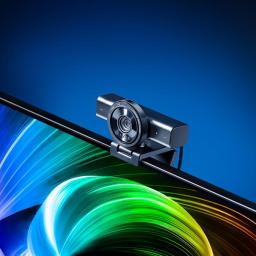 |
on (#70SFV)
Razer is updating its lineup of creator-focused webcams with two new models, the Razer Kiyo V2 and Razer Kiyo V2 X. The webcams offer new AI-powered features and 4K streaming at a more affordable price than the company's Kiyo Pro webcams.The $100 Kiyo V2 X is capable of capturing 720p video at either 60 or 30 frames per second, 1080p video at 24, 30 or 60 frames per second and 1440p video at 60 frames per second. Like some of Razer's other webcams, the Kiyo V2 X has a wide, 83-degree field of view that can be customized with the company's Synapse software. The webcam doesn't have the AI-powered features of the V2, but you do get all the basics, like auto-focus, a privacy shutter and a built-in microphone.For about $50 more, the Kiyo V2 offers higher-quality capture and a few more automated features. The $150 webcam uses an 8.3MP Sony STARVIS image sensor and can capture true 4K HDR footage at 30 frames per second. The V2 also has a slightly wider field of view than the V2 X, at 93 degrees to the V2 X's 83 degrees. Razer is using that extra wiggle room to offer auto-framing - similar to Apple's Center Stage feature - through an integration with Reincubate's Camo Studio software. The Kiyo V2 can keep you in frame, remove your background and offer "adaptive lighting correction," all with the new software improvements Razer and Reincubate are adding.While both webcams are pitched as creator tools, the basic features Razer is offering and the prices its offering them at easily make the Kiyo V2 and V2 X worth considering. At $150, the Kiyo V2 is only slightly more expensive than Engadget's favorite webcam and should, if Razer's claims are true, offer even better video performance.Razer says you can purchase the Kiyo V2 X and Kiyo V2 today, for $100 and $150, respectively.
|
 |
by Will Shanklin on (#70SFW)
Tucked away in Apple's announcement of a second-generation Vision Pro was news on the controller front. First, we already knew that, with visionOS 26, Apple's headset supports PlayStation VR2 Sense controllers. But now you can get them without Sony's headset.The Apple Store will soon begin selling the PS VR2 Sense controllers for $250. (Cue spit take.) The $400 PS VR2 headset bundle was previously the only way to buy them new. Maybe when you can justify spending $3,499 on Apple's reality machine, $250 for the controllers is reasonable.The second-generation Vision ProAppleApple says Sony's controllers open the door to more immersive gameplay on the Vision Pro. They support six degrees of freedom motion tracking (any direction you move or rotate), finger touch detection and rumble support.Apple's second-gen Vision Pro is more powerful with the new M5 chip. It also includes a Dual Knit Band, which adds a top strap for increased stability and comfort. You'll be able to buy the PS VR2 Sense controllers from the Apple Store on November 11.This article originally appeared on Engadget at https://www.engadget.com/wearables/apple-will-sell-ps-vr2-sense-controllers-separately-for-250-next-month-203602932.html?src=rss
|
 |
on (#70SFX)
Device maker Honor has revealed that one of its upcoming smartphones will offer an unusual design choice. While many manufacturers push to have more numerous and powerful cameras in their products, the Chinese company will put the camera for its new phone on a pop-out mechanical arm. According to CNBC, the design of this so-called "robot phone" is meant to showcase Honor's AI capabilities as the company makes a $10 billion investment in artificial intelligence over the next five years. Honor hasn't shared too much about this product, but will likely have more details during next year's Mobile World Congress.Honor has experimented with unusual form factors before, including a surreally thin foldable smartphone and a laptop with a detachable webcam, and we've even seen a similar concept of a pop-up camera several years back in products like the OnePlus 7 Pro phone. The idea to swing out a camera could offer some interesting options for image and video capture, but it's also a prime place for mechanical failures and high manufacturing costs.This article originally appeared on Engadget at https://www.engadget.com/mobile/smartphones/honor-is-making-a-smartphone-with-a-fold-out-camera-201555268.html?src=rss
|
 |
on (#70SDE)
Like clockwork, Apple has introduced a new M-series chip on updated versions of the iPad Pro, MacBook Pro and for the first time, Apple Vision Pro. The new M5 chip shares plenty of similarities with the M4 chip Apple introduced in 2024, but the biggest seems to be a focus on improving graphics and AI performance.The M5 chip is made using a new third-generation 3nm process, according to Apple, with an updated 10-core GPU architecture on all versions that offers four times the peak GPU compute performance of the M4, while carrying over support for things like hardware-accelerated ray tracing. The M5 also features a 10-core CPU, just like the M4, with six efficiency and up to four performance cores.The M5 chip configurations for the iPad Pro.AppleThat is unless you're buying an M5 iPad Pro. The 1TB and 2TB models of the Pro feature a 10-core CPU and GPU, but if you opt for a smaller storage size of 256GB or 512GB, you'll get a nine-core CPU with six efficiency cores and three performance cores. Apple says the 10-core CPU offers "up to 15 percent faster multithreaded performance" over the M4 chip, though it's not clear if that's due to the CPU or memory improvements. That's because the new chip offers an improved memory bandwidth of 153GB/s, up from the starting 120GB/s bandwidth on the M4, though less than what you can get with the M4 Pro or M4 Max. Apple will likely release M5 versions of both chips next year, but it's worth knowing what you're missing if you opt for the M5 right now.The performance gains Apple was able to squeeze out of its new GPU and improved memory bandwidth seem like the biggest changes users will actually notice from the M5. That includes "up to 30 percent faster" graphics performance than the M4 and "up to a 45 percent graphics uplift in apps using ray tracing." Apple introduced the M4 with a focus on dynamic caching and ray tracing, and it seems like the M5 makes both graphical processes more efficient. The gains are apparently even more noticeable on the M5 Vision Pro, where the headset can achieve a 120Hz refresh rate, up from the 100Hz max Apple guaranteed before, and is now able to render "10 percent more pixels."AI performance is also improved, though not necessarily thanks to the M5's 16-core Neural Engine alone, which seems to be the same Neural Engine used in the M4. Instead, Apple's taking a new approach to AI processing by including dedicated "Neural Accelerators" in each core of its GPU. This extra help has led to faster performance when devices are using Apple Intelligence skills or AI-powered features like the Vision Pro's ability to generate a Persona, according to Apple.In-depth testing and benchmarking of Apple's new M5 devices will be required to accurately capture how the M5 chip changes things, especially when it comes to general CPU performance. For now, though, Apple's chips continue to get more graphically powerful, which bodes well for anyone who uses MacBooks and iPads for creative tasks, AI or playing games.
|
 |
on (#70SDF)
It's that time of year when trick-or-treaters are finalizing their costumes and horror movie streaming service Shudder surely sees an uptick in usage. Yes, spooky season is upon us and Sony is getting in on the fun with its PlayStation Plus Game Catalog additions for October.Starting on October 21, Extra and Premium subscribers will be able to play the remakes of Silent Hill 2 and Until Dawn on PS5 at no extra cost. Both games were released last October, so it hasn't taken too long for them to hit PS Plus. For extra spookiness, 2023's Alan Wake 2 is one of the games that all PS Plus members can claim this month, alongside Cocoon and Goat Simulator 3.The other Game Catalog additions this time around are Yakuza: Like A Dragon (PS4 and PS5), As Dusk Falls (PS4, PS5), Poppy Playtime: Chapter 1 (PS4, PS5), Wizard with a Gun (PS5) and V Rising (PS5). Premium subscribers will also get a blast from the past in the shape of Tekken 3 (PS4, PS5), which debuted on the original PlayStation.
|
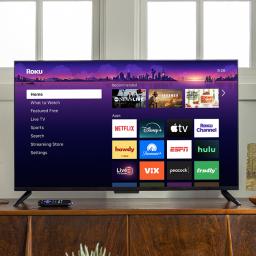 |
by Lawrence Bonk on (#70SDG)
Roku just announced a robust software update coming to many of its devices. These are free upgrades, with search getting a major AI boost.First of all, the pre-existing voice search feature is getting "AI smarts." This means that users will be able to ask contextual questions about movies, actors and shows. It's worth noting that the bot will deliver the answers on-screen and not via a digital voice. This can be used to help find something to watch, as Roku gives examples of people asking how scary a movie is or if something is safe for children to watch.RokuA search bar is being added to the live TV page and it will scour all of the platform's free live channels to find a match. The search tool will also now give more accurate information as to which streaming platform to choose based on active subscriptions and what people are looking for.The dedicated Roku Sports page will be able to track live scores and will let viewers keep tabs on multiple games at once, thanks to matchup tiles. This can be shut off to keep things spoiler-free.RokuThe company's pre-existing Bluetooth Headphone Mode is rolling out to more devices, including the Roku Streaming Stick and Streaming Stick Plus. This lets people connect headphones directly without having to use the dedicated app. Both of those made our list of the best streaming devices, so more functionality is always appreciated.RokuThe app is getting an overhaul, with new shortcuts and the ability to rate shows and movies directly within the app. The company has also revealed that Philips Ambilight technology is now available on Roku TVs in the US. This tech automatically changes the ambient lighting based on what's being shown on-screen. All of these software updates will be available to Roku devices in the coming months.The company also recently refreshed many of its midrange TVs with pro-level features. New Roku Plus Series TVs now allow for hands-free voice control and a feature that automatically adjusts the picture on a scene-by-scene basis.This article originally appeared on Engadget at https://www.engadget.com/home/home-theater/the-latest-roku-update-adds-ai-powered-voice-control-and-better-search-184513277.html?src=rss
|
 |
on (#70SAZ)
For as long as I can remember, I've had trouble going to sleep. When I lay down, my mind inevitably starts racing a thousand miles an hour, thinking about anything and everything.On several recent nights, though, my pre-slumber thoughts had a singular focus. I mulled over possibilities like, "What if I fuse a ball that heals my character with one that splits into smaller balls with the same effect, and add a passive that fires a baby ball every time I'm healed?" Then I grab my PlayStation Portal and do just that until I doze off. This is the hold Ball x Pit has had over me.Kenny Sun and a small group of collaborators have cooked up a mesmerizing brick-breaking roguelite. Ball x Pit is a blend of dual-stick shoot-'em-up action, base building and about a dozen other things that keeps calling me back for one more run... and another, and another.After a cataclysmic event wipes out the city of Ballbylon and leaves an enormous pit, hunters descend into the depths in search of treasure. For our purposes, this means playing levels to collect resources in order to build structures in New Ballbylon. These buildings unlock perks, such as new characters, that help with future runs. The sickly chaos of the levels and the calmer city building aspect feed into each other smartly and combine for a satisfying loop.Base building in Ball x PitKenny Sun/Devolver DigitalThat's not the only important interplay here. Like any good roguelite, Ball x Pit is all about finding synergies for maximum impact. It's right there in the title, with the "x" denoting a relationship between two things (it's derived from shipping in fandom parlance).In the pit, you battle monsters by - surprise! - firing balls at them. Along with regular baby balls," each character has a unique ability and a special starter ball. In the vein of Vampire Survivors, you'll unlock more special balls and passive abilities when you collect enough gems to level up. One ball has a chance to freeze enemies and another is slower but deals much more damage.There are dozens of others.The real fun comes in when you start fusing these balls and their effects together, freeing up space for another weapon. It gets even better when you're able to evolve a pair of balls into something new. It's possible to fuse evolved balls, or even evolve them again. There's a strategic aspect to this, as you won't want to fuse balls that can nearly cancel each other out, such as merging an area-of-effect ball with one that disappears on impact, or leave yourself with too few balls in the face of danger.Once I unlocked the option to take two characters on a run and combine their passive abilities, that's where things went into overdrive. The possibilities became very exciting at this point, and I ended up playing Ball x Pit way past my ideal bedtime as a result.It does take a while to get to that point, though. Progression is slow at first. The repetition can get to be a little much as you need to beat each stage multiple times before moving onto the next. Also, I wish there was a bit more to the game narratively than a basic setup and some character descriptions.But there's so much to consider on each run, and that's what keeps me coming back. Each of the nine levels is set in a different biome, with its own hazards, enemies and bosses. Some late-game characters turn the game on its head by shifting playstyles in surprising ways, but I don't want to spoil those. Along with the absolute chaos and dopamine hits of slicing through enemies, discovering killer combinations between characters, special balls - especially the evolutions - and passives drives so much of the joy of this game.Whenever you do fuse or evolve a pair of balls, rather than having to click an "OK" button to get back in the action, the prompt reads "Whoa." That's on the nose, but funny. And I'll be damned if I didn't say that very thing out loud many times when I saw what a new evolved ball could do.Ball x Pit is out now on Steam, PS5, Xbox Series X/S and Nintendo Switch for $15. It's available via Game Pass Ultimate and PC Game Pass. A Nintendo Switch 2 version is coming later this fall with a free upgrade from the Switch version.This article originally appeared on Engadget at https://www.engadget.com/gaming/ball-x-pits-deeply-satisfying-grind-keeps-me-coming-back-for-more-171000754.html?src=rss
|
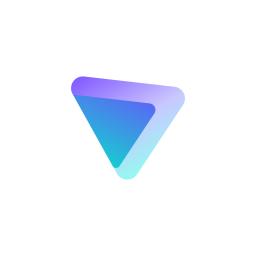 |
by Sam Chapman on (#70SB0)
Proton VPN currently tops my list of the best VPNs, and I gave it a glowing recommendation in my detailed Proton VPN review. It's easy to use, fast, cheap and secure, with a large server network and one of the industry's best scores at unblocking streaming sites. All that said, there's no such thing as a perfect VPN, and you may find that Proton isn't working for you. If that happens, here's how to cancel your subscription.How to cancel Proton VPN through a browserIf you initially signed up less than 30 days ago, you can cancel your subscription and request a refund by contacting tech support. See "How to get a refund from Proton VPN" below for details. If more than 30 days have passed, use the following steps to cancel your subscription.
|
 |
on (#70SB1)
The VSCO photo editing and sharing app has been around for nearly as long as Instagram, positioning itself as the serious photographer's choice for mobile editing. The original focus was on tasteful filters and editing tools, all of which got significantly more powerful and flexible over time; VSCO has long been doing the same sort of film emulations that have made Fujifilm's cameras so desirable in recent years. The company also built up a loyal community of photographers who share their edits far and wide, both in the VSCO app as well as on more mainstream platforms like Instagram itself.Now, the company is making an unsurprising but potentially controversial move: it is releasing its first AI-powered image editing tool. Remove," as the name suggests, lets you erase unwanted elements" from your photos without compromising the image's full resolution. At first glance, it feels quite similar to tools like Google's own Magic Eraser. You just pop open an image in the editor and highlight the portion you want to remove, and VSCO will do its best to obliterate the offending bits and fill in whatever is in the background that it deems appropriate.I haven't had a chance to test how effective this tool is yet, but VSCO is using Black Forest Lab's FLUX.1 Kontext model to do its magic, combined with its own proprietary technology specifically focused on making results that the company says look authentic. A quick look at Black Forest Lab and the FLUX.1 model show a tool that does appear to be well-suited to removing unwanted parts of an image and properly filling in the space that remains -but we'll have to see it in action to judge whether it does the job well.This new Remove tool isn't the only AI-powered editor VSCO is working on. There's also an Upscale tool in the works that the company says will enhance image resolution" while keeping color and composition unchanged. These sorts of tools will live under a new umbrella the company is calling AI Lab, making it clear this will be an ongoing initiative and not just a one-off release.On one hand, I'm not at all surprised to see VSCO jumping into AI-powered editing; it has to keep up with the rest of the industry. But on the other hand, the company has made its mark by building a community of photographers who value authenticity in their work, something that cannot help but be in conflict with AI tools, at least on the surface.VSCO's CEO Eric Wittman acknowledged that tension in a conversation with Engadget. We have a very photographer-centric, creator-first point of view," Wittman said. But where we see AI fitting in is in support of those folks, and that work, and that vision. The intention isn't to replace [that work], though - AI has a place, but it's not to replace what creators, and photographers in particular, are doing."That mindset makes sense with something like Remove, which duplicates something people have done with Photoshop for years. Rather than generating new images or radically changing the truth of a photo like you can do with some of Google's tools on the Pixel phones, Remove is a bit more subtle. You would use masks, you would manually painstakingly edit things at a pixel by pixel level," Wittman said. What a lot of Remove tools would do is basically like automate that."Wittman also cited preserving image quality as a key part of the work behind its own Remove tool. We know that many people who were attempting to use AI in the early days, especially photographers, a lot of their disappointment was just in the preservation of the integrity and the quality of the work," he said. So what we've really tried to do is continue to help automate where we can and make things easier, but also preserve the quality." To that end, VSCO is stressing that all these edits are non-destructive and the output will be in full, original resolution.As VSCO starts dabbling in more AI editing tools, Wittman emphasized that the company wants to stay on the side of helping photographers realize a creative vision rather than helping them make entirely unreal images, while also avoiding the mess of copyright issues and inauthentic content that is flooding the internet thanks to AI. When you think about things like copyright, and the incredible importance of copyright, integrity, and authenticity - we're big believers as a company in both the laws and the norms that have been around for many many years. But obviously on some platforms there are people who are maliciously manipulating things, and we don't want to be participants in that."VSCO's first AI Labs feature is available as of today in the VSCO app for iOS; it should come to Android eventually but there's no word yet on specific timing. To use it, you'll need an active VSCO Pro subscription, which runs $13 per month or $60 a year. A Pro plans contains a ton more than just AI Labs features, though -it unlocks a full editing suite on mobile and the web, professional profile and website creation, hundreds of presets and film emulation settings and a lot more.
|
 |
by Matt Tate on (#70SB2)
Apple has been expected to widen its smart home offering for a long time now, and if a new report is accurate, we could be getting a trio of new devices fairly soon. According to Bloomberg, Apple is working on an indoor camera and a smart display to arrive in 2026, as well as a tabletop robot, with the latter expected to launch in 2027.An Apple-made smart display in particular has featured heavily in the rumor mill for a number of years, but it appears to be closer than ever. Bloomberg's Mark Gurman reports that Apple's new home hub will have a 7-inch square LCD display, a built-in FaceTime camera and an OS that dynamically adjusts depending on who's using it. It will also ship with an improved version of Siri that will behave more like ChatGPT or other chatbots in how it uses the web to answer your questions. The product, along with the more advanced Siri chatbot, had been slated for release earlier this year, but Apple reportedly scrapped those plans in favor of a spring 2026 launch.Bloomberg claims there will be two versions of the home hub, one code-named J940 which takes the form of a display mounted on a HomePod mini-like speaker, and the other (J491) designed to be hung on a wall. With both you'll be able to control smart appliances, play music and presumably interact with Apple's various apps on other devices. Apple is said to be targeting a price of around $350, although the Bloomberg report does not specify which version of the device that price refers to.The tabletop robot scheduled to launch in 2027 will effectively be the smart display Apple could be releasing next year mounted into a motorized arm that can move the device to different positions, which sounds like the company's take on Amazon's (slightly creepy) swivelling Echo Show 10, first launched in 2021. This product will have a larger 9-inch display, but is said to be delayed after Apple encountered engineering challenges with the motor.Bloomberg reports that all three of these devices will be built in Vietnam, which sources said represented a "major change" in how Apple launches a new product category, as it has traditionally relied on China at the outset. In 2020 it emerged that Apple was looking to diversify its production by moving some of its iPad and MacBook manufacturing to Vietnam, and the US' trade war with China has only intensified during Trump's second administration. Vietnam has not escaped tariffs of its own, but they're less severe than imports from China.This article originally appeared on Engadget at https://www.engadget.com/home/apples-long-rumored-smart-display-will-reportedly-cost-350-165801748.html?src=rss
|
 |
by Steve Dent,Kris Holt on (#70S22)
The new M5 MacBook Pro has arrived - and brought something of a strategy change for Apple's chip release strategy this year. This time around, Apple has led with the entry-level 14-inch MacBook Pro, which retains the same $1,599 starting price as its M4 predecessor. It debuts alongside new 11- and 13-inch iPad Pros and a refreshed Apple Vision Pro that have the same M5 chipset, but - unlike last year - there's no M5 Pro and M5 Max devices to be found. In the past, Apple has favored launching its entire MacBook Pro lineup at once, as it did in 2024 with the M4, M4 Pro and M4 Max models. However, it may have decided to release the M5 model now so it could get a jump start on sales, since the M5 Pro and M5 Max versions are reportedly still several months away. Apple may have also opted for a low-key release since the M5 MacBook Pro is largely unchanged from the previous model. With that, the emphasis is squarely on the M5 chip and its extra performance. Reportedly due to cost reasons, Apple decided to use the same 3-nanometer fabrication process for the M5 as it did for the M4. The new chip has 10 GPU cores and 10 CPU cores, along with a 16-core Neural Engine. Apple claims the M5 has the "world's fastest CPU core" with up to 20 percent faster multithreaded performance compared with the M4 chip. As for the GPU, the company says that offers "up to 1.6x faster graphics performance in pro apps and enables up to 1.6x higher frame rates in games compared to the M4 model." That should make the M5 MacBook Pro a better option than the M4 model for things like gaming and video editing. To that end, compared with the M4 MacBook Pro, Apple says the latest model delivers up to 1.8x faster "AI video-enhancing performance" in Topaz Video, up to 1.7x faster 3D rendering in Blender and up to 1.2x faster build performance during code compiling in Xcode. The company is promising 3.5x faster AI performance than with the M4 model, and up to 6x faster performance than M1. It also claims SSD performance is up to twice as fast as the previous generation. The M5 MacBook Pro comes with the same 14.2-inch, 3,024 x 1,964 Liquid Retina XDR display that can hit 1,000 nits in SDR mode and up to 1,600 nits peak brightness for HDR content. It has adaptive refresh rates at up to 120Hz and offers a wide P3 color gamut with up to 1 billion colors, ideal for video editors and Lightroom users. Other key features include an SDXC card slot, HDMI port and 3.5mm headphone jack. There are three USB-C ports as before, but they're still the Thunderbolt 4 type with speeds up to 40 Gbps, and not the 80 Gbps Thunderbolt 5 ports found on M4 Pro and Max models. It also comes with a six-speaker system with support for Dolby Atmos and Spatial Audio as before, along with Wi-Fi 6E, Bluetooth 5.3 and a 12MP Center Stage 1080p webcam. As you might imagine, it comes with macOS Tahoe ready to go. Per the comparison page on Apple's site, except for the different CPU, the M5 MacBook Pro otherwise has identical specs to its M4 predecessor, right down to the same dimensions, weight and 70-watt power adapter. The 14-inch M5 MacBook Pro is now available for pre-order starting at $1,599 with 16GB memory and 512GB storage. It maxes out at 32GB of RAM and 4TB of storage. Shipping will start October 22. Update, 12:52PM ET: Confirmed via Apple's spec page that there are no real differences between the M4 and M5 MacBook Pro aside from the new CPU. This article originally appeared on Engadget at https://www.engadget.com/computing/laptops/apples-first-m5-laptop-is-the-14-inch-macbook-pro-131314446.html?src=rss
|
 |
by Lawrence Bonk on (#70S8A)
Fujifilm just announced the Instax mini LiPlay+ instant camera, which is a refresh of the original mini LiPlay from 2019. It's been six long years, so the company has added some nifty features here.First of all, there's a second camera on the rear that's intended for selfies. It features a wide-angle lens and joins the pre-existing front-facing camera. There's a new functionality that lets users combine the content from both cameras to create unique layered images. That's pretty nifty.
|
 |
by Lawrence Bonk on (#70S8B)
The Ring Battery Doorbell is on sale via Amazon for just $50. This is half off and matches the Prime Day price, only now the deal is available for everyone. The sale applies to both colorways. This is the company's entry-level video doorbell but it's still got some nifty features. First of all, it's powered via a rechargeable battery, so users don't have to do any wiring to get started. It charges via an included USB-C cable. The Ring Video Doorbell is a relatively new design, having been first released in the middle of last year. It offers improved video when compared to the previous generation, in addition to a 23 percent increase in battery life. It can also handle head-to-toe video, which is handy when trying to suss out who is at the door. The doorbell sends out real-time alerts and there's a live view available via the smartphone app. This app also allows for conversations. It can hold onto recordings via the cloud, but only for those subscribed to Ring Home. A subscription includes access to 180 days of video history, but does cost $5 to $20 per month. Follow @EngadgetDeals on X for the latest tech deals and buying advice.This article originally appeared on Engadget at https://www.engadget.com/deals/this-battery-powered-ring-doorbell-is-on-sale-for-50-right-now-150926669.html?src=rss
|
 |
by Mariella Moon on (#70S8C)
It took two years for Threads to get messaging, but you thankfully don't have to wait that long to be able to start group DMs. Meta has started rolling out group chats for the app, which lets you add up to 50 of your followers to a single conversation. Just start a new message and add anybody who follows you on Threads. The company says that you'll also be able to share a link that your followers can click to join a group conversation "soon," so you don't have to add them one by one. Like in messaging apps, you'll be able to customize the group chat's name to better reflect its topic.In addition to launching group DMs, Meta is also releasing the messaging feature in the European Union over the coming days. If you're in the EU, you'll get access not just to individual DMs, but also to group DMs, messaging controls, privacy settings, the hidden folder where spam goes to and support for media files when the feature becomes available in your country.Emily Dalton Smith, Meta's Head of Product for Threads, told us in a test group chat that it's "on track to become Meta's next major app" with 400 million monthly active users." Messaging has been the top requested feature since Threads launched, but it took some time to release it because it "wasn't a priority in the early days." Since making DMs available on Threads in July, Meta has added support for photos, videos and GIFs, a messaging requests folder to reduce unwanted messages, the hidden spam folder and a privacy setting that completely switches off message requests from people you don't follow.Threads / MetaThis article originally appeared on Engadget at https://www.engadget.com/social-media/threads-now-supports-group-dm-150002493.html?src=rss
|
 |
by Matt Tate on (#70S57)
Waymo is bringing its autonomous taxis to the UK in 2026, marking the company's first major expansion outside of the US. Waymo has selected the mobility company, Moove, as its fleet operations partner, and is currently working with local and national authorities in the UK to gain the necessary permissions to launch a robotaxi service in London first next year.Right now, you won't find any fully driverless cars in London or anywhere in the UK, but that's set to change next year when the Automated Vehicles Act 2024 begins to take effect. This legislation is intended to regulate the eventual arrival of self-driving vehicles in the UK, but before that can happen, the government will help to facilitate robotaxi pilots from Spring 2026.Given its complex road network and narrow winding streets built long before cars were a concern, London will be a challenging city for Waymo's robotaxis to navigate, but the company said in a statement that its technology significantly reduces the risk of injury-causing collisions with other vehicles and pedestrians compared to human-driven cars. The imminent arrival of Waymo in the UK was also welcomed by the Royal National Institute of Blind People (RNIB), with self-driving taxis seen as an important first step in ushering in autonomous travel on a larger scale.Waymo already has close links to the UK, with its first international engineering hubs located in London and Oxford. It also has a partnership with UK-based Jaguar Land Rover, which sees it equip all-electric Jaguar I-Pace taxis with its Waymo Driver self-driving tech in the US.However, Waymo won't be without competition when its service arrives in London next year. Uber and Wayve are planning for their own pilot to launch around the same time, after the latter's CEO and co-founder, Alex Kendall, called the arrival of the Automated Vehicles Act "a defining moment for UK autonomy."This article originally appeared on Engadget at https://www.engadget.com/transportation/evs/waymo-plans-to-launch-fully-autonomous-taxi-service-in-london-next-year-142453250.html?src=rss
|
 |
by Mariella Moon,Devindra Hardawar on (#70S58)
Apple has introduced an upgraded version of its Vision Pro headset that's powered by the company's M5 chip, its latest silicon that will also come with the new iPad Pro and MacBook Pro. The first generation of the headset was equipped with Apple's M2, so you can expect this device to be faster and come with more capabilities. Apple hasn't budged the price from $3,499 with 256GB of storage, but at least it comes with a Dual Knit Band, which adds a top strap for extra security and comfort. (Existing Vision Pro users can also buy the Dual Knit Band separately for $99.)As you'd expect, Apple claims the refreshed Vision Pro should be faster while loading apps, browsing the web and doing just about everything. The M5 chip also includes a new 10-core GPU, with better support for hardware-accelerated ray tracing and mesh shading, "enabling developers to add remarkable detail to lighting, shadows, and reflections in games like Control," according to Apple. The company also says the M5 Vision Pro renders 10 percent more pixels on its micro-OLED displays, which should make everything look a bit sharper.The M5 Vision Pro should last a bit longer than the original model, as well. Apple claims it supports up to two and a half hours of typical usage, and up to three hours of video playback. The previous model was rated for two hours of general usage and two and a half hours of video viewing.Bloomberg's Mark Gurman reported a few days ago that Apple was due for another wave of product announcements. He wrote back then that the new iPad Pro and Vision Pro are already being mass produced and that Apple is "gearing up for an imminent release." Apple had originally wanted to launch a a lighter and cheaper version of the Vision Pro headset, as well, but it reportedly decided to shift its focus on the development of smart glasses. The company pulled people working on the lighter Vision Pro, Gurman said in another report, and moved them to its smart glasses project.Apple is reportedly working on a smart glasses model with no display and is meant to pair with iPhones, along with another model that's equipped with a built-in screen and can directly compete with Meta's Ray-Ban Display. The company is aiming to release the model with no screen in 2027 and the one with a screen in 2028, Gurman said."The Vision Pro is a flawed product, but it's certainly not empty," we noted in our review of the original headset. "It's as if Apple has compiled everything it's learned from building the Mac, iPhone, Apple Watch and AirPods into a single device, all in a bid to avoid the Innovator's Dilemma." At first glance, the M5 Vision Pro doesn't seem to change that conclusion much, not without more content and apps built around spatial computing. A price drop and more storage on the base model would certainly make the Vision Pro more compelling, until that happens it'll remain more of a developer kit than a full-fledged consumer product.The M5 Vision Pro is now ready to pre-order and will once again set you back $3,499. Apple will start shipping the device on October 22.This article originally appeared on Engadget at https://www.engadget.com/ar-vr/apples-new-vision-pro-gets-an-m5-chip-and-dual-knit-band-but-its-still-3499-132123957.html?src=rss
|
 |
by Steve Dent,Nathan Ingraham on (#70S23)
Apple's latest 11- and 13-inch iPad Pros have arrived, and though they're the first with the company's all-new M5 chip, they're otherwise largely identical to last year's models. The main reason to buy one, then, would be for the extra performance over the M4 - something that may be worthwhile to content creators and other power users looking for a tablet instead of a laptop. Last year Apple decided to debut its M4 chip with the iPad Pro lineup and not its laptops. The reason? Only the entry-level M4 was ready (and not the M4 Pro and M4 Max), so Apple decided to wait before putting in its MacBooks so it could launch the entire lineup at once. With updated Magic Keyboards, It also showed that Apple was marketing the iPad Pro as a feasible MacBook replacement for power users. The same applies with the M5, except this time the company also launched its entry-level 14-inch MacBook Pro at the same time. As before, the new M5 processor uses TSMC's 3-nanometer process, as Apple reportedly decided against 2-nanometer chips due to cost considerations. The entry-level M5 comes in a couple of versions. The iPad Pro with either 256GB or 512GB of storage gets an M5 with a 9-core CPU (3 performance cores and 6 efficiency cores), 10-core GPU and 12GB of RAM. The 1TB and 2TB models get a fourth performance core and 16GB of RAM. The big upgrade here appears to be to the GPU; Apple says each of the 10 GPU cores have a Neural Accelerator on board, which will allow GPU-based AI processing to run significantly faster than on the M4. Apple claims it has more than four times the peak GPU compute performance of the M4 (which is only about 18 months old, mind you). Graphics performance should be about 45 percent higher than on the M4, as well. Overall multithreaded performance is 15 percent faster than the M4, and Apple says that video transcoding is six times faster than what the old M1 iPad Pro from 2021 delivered. As for battery life, Apple claims the same 10 hours that basically every iPad has ever been rated at. But for the first time, the iPad Pro supports fast charging - you can get up to 50 percent in 30 minutes using a 60W USB-C power adaptor. Apple is also using the C1X modem that it originally introduced last month in the iPhone Air; that'll provide the optional 5G service that Apple has offered on iPads for a few years now. There's also an N1 chip (also found in the iPhone Air), which is an Apple-designed networking chip for Wi-Fi 7, Bluetooth 6 and Thread connectivity. Apple claims this new chip will make features like Personal Hotspot and Airdrop more reliable while also offering improved performance on 5GHz Wi-Fi networks. As before, the 2025 iPad Airs are extremely thin and light. The 11-inch model is 5.3mm thick and tips the scales at just under one pound, while the 13-incher is just 5.1mm thick weighs 1.29 pounds. Both feature "tandem" OLED Ultra Display XDR screens that hit up to 1,000 nits brightness and peak at 1,600 nits - so they're perfect for viewing and editing HDR content. The new iPad Pro starts at $999 for the 11-inch model with 256GB of storage ($1,199 with 5G) and $1,299 for the 13-inch ($1,499 with 5G). Those are the same prices as last year - still extremely expensive, but at least not more than before. You can pre-order the new iPad Pro now, and it'll be available on October 22. This article originally appeared on Engadget at https://www.engadget.com/mobile/tablets/apples-latest-ipad-pro-get-a-power-boost-with-the-new-m5-chip-131036435.html?src=rss
|
 |
by Sam Rutherford on (#70S24)
Xbox is at a crossroads. While the PlayStation 5 and Switch 2 continue to gain popularity, multiple price hikes for the Xbox Series S and X have killed their momentum. And with several big box retailers like Costco deciding to drop Microsoft's console from their shelves, the current-gen Xbox may be dead in the water. So what should the company do? Microsoft's most straightforward option would be to simply punt the end of the Xbox's lifecycle, regroup and come back strong with a brand new console in a year or two. On the flipside, the company could follow in Sega's footsteps after the untimely demise of the Dreamcast and become a cross-platform game publisher with a large stable of first-party studios. However, there's a third route that could fill the gap between now and whenever the next Xbox arrives that could potentially expand its reach to a whole new segment: Give handheld gaming a go. Engineering and building a new portable gaming device isn't cheap or quick. So instead of doing everything itself, Microsoft teamed up with ASUS to create the ROG Xbox Ally and ROG Xbox Ally X - a pair of Windows 11-based portable gaming PCs enhanced with Microsoft's DNA. And while it's too early to say if these handhelds will help save Xbox itself, they're more than solid portables that could have a big impact on portable gaming going forward. Editor's note: This review is focused on the ROG Xbox Ally X, primarily because that's all we have at the moment. However, the Xbox Ally and Xbox Ally X share many features including the same basic design , display, button layout and software (the only difference is their color). That said, the base Xbox Ally has less impressive specs as it comes with a slower AMD Ryzen Z2 chip, 16GB of RAM, 512GB of storage and a smaller 60WHr battery. It's also a touch lighter (1.48 pounds vs 1.58) and has a lower price of $600 instead of $1,000. Design and display: The Xbox goes portable Sam Rutherford for Engadget When you look at the ROG Xbox Ally X, it might appear as if ASUS bolted larger grips to its previous handheld - the Ally X - and called it a day. However, the company says the Xbox Ally was redesigned from the ground up, in large part to include a number of signature features that will make Xbox faithful feel right at home. This includes things like the classic ABXY button layout, Impulse triggers with tons of travel and, of course, the requisite Xbox home button. Then smack dab in the middle of everything is a 7-inch IPS LCD screen. Speaking of the display, ASUS picked a FHD IPS panel with a 120Hz refresh rate that appears to be the exact same screen used on the Ally X. While it doesn't deliver pure blacks like you'd get from OLED, contrast was still surprisingly good. With a brightness of 500 nits (the one on our review unit was actually a touch higher at 510 nits), this display delivers almost everything you want without feeling like you need to upgrade to something like the huge 8.8-inch OLED panel on the Lenovo Legion Go 2. Sam Rutherford for Engadget Around back, there are two customizable paddles while the top edge houses a fingerprint reader and all of the Xbox Ally X's connectivity: two USB-C ports, a microSD card reader and 3.5mm audio. Notably, while both ports support charging and display capabilities, the one furthest to the left is also Thunderbolt 4 compliant. This means it has enough bandwidth to support external GPUs like ASUS' recently updated XG Mobile graphics dock. Ultimately, the ROG Xbox Ally might not look all that different from ASUS' previous handhelds, but between its buttons, triggers and those big new grips, it really does feel like you're holding a portable version of Microsoft's console. Even without Hall Effect sensors, the Xbox Ally X's joysticks are tight and responsive, while the triggers offer a ton of travel. The only thing I wish ASUS and Microsoft had paid a little more attention to is the handheld's haptics, which are fine, but they're a far cry from the expressive rumble motors you get from a DualSense controller or the Switch 2's Joy-Con. Performance: Flagship handheld power Sam Rutherford for Engadget As the higher-end model in ASUS and Microsoft's new joint handheld lineup, the ROG Xbox Ally X features a AMD Ryzen Z2 Extreme chip with 24GB of memory (which is shared with its GPU) and 1TB of storage that can be expanded via microSD. However, thanks in part to the new full-screen Xbox experience, Microsoft tweaked a number of the handheld's background processes and services for the first time on a Windows 11-based handheld. The result is a slightly more optimized device even when compared to its closest rivals. In Cyberpunk 2077 at 1,920 x 1,080, medium graphics and FSR set to performance, the ROG Xbox Ally X hit 62.1 fps while plugged in and set to its max 35-watt Turbo mode. That's almost five fps higher than what we got from the Lenovo Legion Go 2 (57.5 fps) when its settings are similarly maxed out. Admittedly, this might not sound like a huge improvement, but it ends up being an extra seven percent performance from the same chip, which ain't bad. Meanwhile in Returnal, I got similar numbers after switching to the Ally's more energy-efficient 17-watt Performance Mode (unplugged), where it produced 42 fps at full HD on medium versus 39 fps for the Lenovo. Sam Rutherford for Engadget That said, it's important to note that the Ally's performance changes depending on whether it's plugged into the wall or not. If you want its full 35-watt Turbo Mode, you're going to need to use a power adapter, while its 17-watt Performance and 13-watt Silent modes stay the same no matter what you do. There's also a manual performance customization tool, but to access it, you'll need to switch over to ASUS' Armoury Crate app, as there isn't a place to change things directly inside the Xbox app. Software: The tailored gaming experience we needed Getting excited about the software on a gaming handheld is usually pretty difficult. However, between the aforementioned tweaks to background services and the new full-screen Xbox experience, Microsoft has managed to remove a ton of the clunkiness that typically plagues other Windows-based gaming handhelds. Instead of having to wade your way through the traditional Windows desktop before booting into a game, now you're greeted by the Xbox app upon startup (and even during initial setup), so there are fewer steps to get between you and your favorite title. Furthermore, Microsoft has come up with a revamped layout that makes core features super easy to find. The Home tab is where all your installed software is, while there are other dedicated sections for Game Pass downloads (assuming you have a subscription) cloud gaming/remote play (also via Game Pass) and the Microsoft Store. If you prefer other digital marketplaces like Steam or Epic, there are shortcuts to download installers for those stores (and a few more like GOG and Ubisoft) in the My Apps tab. You don't need to open a web browser and do things manually. To switch between apps in Microsoft's new full-screen Xbox experience, all you need to do is swipe up from the bottom of the ROG Xbox Ally X's screen. Sam Rutherford for Engadget Furthermore, hitting the Xbox button summons a handful of quick settings for all sorts of things, including the Command Center for performance, toggles for Wi-Fi and Bluetooth, your Xbox friends list and a whole lot more. It's kind of like a do-everything button and it makes accessing almost all of your most important tools and features quick and easy. On top of that, there are new gestures that you can access by swiping in on the screen in different directions. Dragging your finger in from the left calls up the Xbox Game Bar overlay, even when you're in the middle of playing a game, while swiping in from the right opens your Windows notifications. But my favorite command is swiping up from the bottom, which is a new way to switch between apps (or a cooler version of Alt + Tab, depending on how you look at it). From there, you can even scroll through any programs that are currently open just by tapping the Xbox Ally's shoulder buttons. If you want to use the handheld like a real PC, you can also activate the Windows desktop from there too. Microsoft has also thoughtfully included compatibility tags on a number of games in its store to give buyers a sense of how well a game will run on the ROG Xbox Ally X. Sam Rutherford for Engadget The redesigned Xbox experience is very breezy and handles 90 to 95 percent of your traditional gaming functions, but there are still times when some of Window's underlying awkwardness shows through. Most often, I found this happens when exiting a game from a third-party store, where the Xbox Ally will spit you out into your Steam library (for example), where you'll often have to rely on touchscreen controls instead of the joysticks or the desktop mode's mouse cursor to navigate around. It's not a big deal compared to other Windows-based handhelds, and even though Microsoft has taken a big step forward on the Xbox Ally, there is still a little polishing to be done. Battery life: A solid jump in longevity One of the biggest benefits of going with the ROG Xbox Ally X is that it comes with a larger 80WHr battery than the base model (60Whr). When that is combined with improved energy efficiency from its new chip, you get very solid battery life - just as long as you don't max out the power settings. Sam Rutherford for Engadget I tested this by playing Clair Obscur: Expedition 33 at full HD on medium settings and max brightness (Protip: don't do this at night if you want to get to sleep on time) and the Xbox Ally X lasted just shy of three and a half hours. That's 30 minutes longer than what I got from the Legion Go 2, although considering the latter has a much larger screen (with the same 500 nits of brightness), that difference wasn't a big shock. The bigger revelation is that when compared to the original Ally X, ASUS and Microsoft's new jointly-made device provided an extra hour of runtime, which could make a meaningful difference on a long trip. Wrap-up While Microsoft's first real foray into PC gaming handhelds isn't upending the status quo and it's way too early to say if this gadget will save Xbox as a whole, it is bringing some notable advancements. The new full-screen experience makes launching and playing games on Windows-based devices so much more seamless that it's kind of wild it took so long to get here. Sure, there are still a few edge cases where you'll have to tap the screen or flip between the Xbox app and ASUS' Armoury Create to tweak certain settings, but compared to most of its rivals, the ASUS ROG Xbox Ally X is a massive upgrade in general usability. Here is a size comparison between the ASUS ROG Xbox Ally X (bottom) and the Lenovo Legion Go 2 (top). Sam Rutherford for Engadget The bigger grips and a familiar button layout will instantly make longtime Xbox fans feel right at home. And thanks to the new chip and more processes and services that run in the background while you're gaming, you get class-leading performance and battery life. Aside from lackluster haptics, the ROG Xbox Ally X's biggest issue is its price. I totally get that there's a growing number of gamers who constantly crave better performance from their portable PCs. However, the trade-off for all this is a much bigger hit to your wallet. It wasn't that long ago when the going rate for a premium handheld was more like $500, which made it easier to afford. After all, those devices weren't really designed to be your main gaming rig like a laptop or desktop. Ultimately the biggest deciding factor for purchasing the ROG Xbox Ally X may be how much someone is already invested into the Xbox ecosystem. If you're a fan of other game stores or you don't have a subscription to Xbox Game Pass or a ton of friends on the platform, you won't get the full benefit of everything Microsoft has integrated into the handheld's new software. This goes double for devotees of Valve's digital store and Linux-based OS that don't need bleeding edge performance, who can safely stick to much more affordable Steam Decks or the Legion Go S. Alternatively, if you want a versatile portable with a giant OLED screen and detachable controllers, the Legion Go 2 is worth consideration as well. Though at $1,300 for the model with a Z2 Extreme chip, it's even more expensive than this new handheld Xbox. Still, despite some minor caveats, Microsoft has finally put its spin on portable PC gaming (with an assist from ASUS) and brought some welcome upgrades to the space that have made the ROG Xbox Ally X a top shelf device.This article originally appeared on Engadget at https://www.engadget.com/gaming/pc/asus-rog-xbox-ally-x-review-an-extra-life-for-xbox-130050224.html?src=rss
|
 |
on (#70S25)
Every now and then, you review a product you can't get along with in any way, shape or form. Sometimes, it's about the quality of the hardware, but more often it's about the philosophy of its makers. Imagine trying to review a toilet built by, and for, aliens from the planet Zog: You can appreciate the intention behind it, but you'll never be able to praise it. That's the issue I've had with Halliday's smart glasses, because almost every design decision made by its creators feels, to me, like the wrong one. Cofounder Carter Hou conceded that some people love Halliday's approach and others haven't taken to it anywhere near as much. Sadly, I've found myself in the latter category. Halliday announced itself to the world at CES in January, dragging behind it a truckload of promises about its Wayfarer-style smart glasses. It said the glasses would be invisible to onlookers," styled to be as close to a regular pair of specs as it could manage. There'd be no outward facing camera or sensors, just a tiny interior display projecting data into the wearer's view. It talked up its proactive" AI assistant that was always listening and would pipe up with an answer when asked a question. It would be discreetly controlled with a touchpad ring, so you'd not need to visibly fiddle with your phone or the glasses' touch-sensitive arm to use it. Plus, it would weigh just 35 grams. What's not to like? The company launched a Kickstarter at the end of January, earning $3,305,917 from more than 8,000 backers. The company has already shared its first product with backers, and it's now ready to share it with retail customers. I've been testing the hardware for around a month with regular software updates. Halliday assured me that the last few issues, like inconsistent Bluetooth connectivity, should be ironed out by the time it's available to the masses. Hardware Halliday's chunky Wayfarer-style glasses are made out of plastic, with thin plastic lenses set to your prescription. Plastic is obviously easy to work with and affordable, but it also can give the appearance and feel of looking a bit cheap and flimsy. Even the temple tips are made of solid plastic, which means they can't be adjusted to suit your head shape and comfort levels.The only way to modify how they sit on your face is by contorting the nose pads, which you'll be told to do during setup. On the underside of the right temple tip, you'll find a rubber gasket covering its built-in USB-C charging port. Follow it towards the front and you'll find one of two speakers (its twin sits on the opposite arm), the touch surface for control and the power button. Sitting over the right lens is a little plastic cantilever arm, on the end of which is a 3.6mm round microLED display module. The arm can be pulled in or out and tilted up and down to put the display into your peripheral vision. The aim, as stated, was to make a small and light pair of glasses that wouldn't draw attention to themselves. Sadly, Halliday couldn't avoid the issue that plagues all smart glasses, which is that they have to be bigger to accommodate all the electronics. But, to my eye, they only just about register as a bold style choice rather than as a comically-oversized pair of specs. I keep flip-flopping on this: Half the time, they're bold, half the time, I feel like I'm wearing faux Marx-brothers glasses from a Halloween store. Daniel Cooper for Engadget The control ring is available in US sizes 8-15, and is made of silver plastic with a small clickpad section embedded. Continuing Halliday's focus on subtlety, the ring's only distinguishing mark is a small black line on one side of the clickpad to indicate the right hand side. Slide the ring on without remembering to check its orientation and you'll be trying to use the menus upside down and back to front. Like a lot of smart rings, it'll certainly stand out on your hand if you're used to thinner, daintier adornments. The control ring is available in US sizes 8-15, and is made of silver plastic with a small clickpad section embedded. Continuing Halliday's focus on subtlety, the ring's only distinguishing mark is a small black line on one side of the clickpad to indicate the right hand side. Slide the ring on without remembering to check its orientation and you'll be trying to use the menus upside down and back to front. Like a lot of smart rings, it'll certainly stand out on your hand if you're used to thinner, daintier adornments. Display Closeup image of the Halliday Smart Glasses display Daniel Cooper for Engadget It's easy enough to put a teeny-tiny display close to your eye, ostensibly tricking it into thinking it's much larger. The 3.6mm microLED module is meant to project the equivalent of a 3.5-inch display into your field of view. It's the same sort of barebones green monochrome display found in a lot of wearables since green is easy to read and not too power-hungry. Again, the focus on invisibility means you're meant to flick your eyes toward it, read what you need and flick back before anyone's really noticed. There are many reasons why this is a smart choice compared to companies using waveguide prisms embedded in the lenses itself. It saves a lot of weight, makes what you're looking at far more private and cuts down the cost. Since, after all, you can just use cheap regular or prescription lenses in the frame, rather than specialist ones with the built-in prisms. But the use of a tiny-display-close-to-your-eye is a problem if you are already a glasses wearer. After all, the screen is behind the prescription, so it's not as simple as just glancing or catching it in my peripheral vision. In my experience, I'd get a notification, look up, and then have to wait for my eyes to refocus before I could see what was going on. That's not a big deal if it's just the time or an icon telling you there's a new WhatsApp, but it's hard to read full sentences of text. Personally, I found the display to be too close and too unnaturally placed for me to comfortably use it. I tried every adjustment possible to make it easier to use, even wearing them in silly ways to no avail. And this gets worse when you're being asked to engage with the lengthy responses produced by its Proactive" AI. Reading paragraphs of text on a 3.6mm screen is a one-way ticket to the sort of eye pain you'd normally only experience after downing a pint of ice cream. If you struggle to use those sorts of displays, then you'll also struggle with the other text-heavy features the glasses offer. Most notably, its reactive" AI, translation and Cheatsheet - its teleprompter-esque service for presentations. In use Image of the rear temple tips of the Halliday Smart Glasses Daniel Cooper for Engadget Once you've followed the YouTube clip guiding you through setup, you'll control your glasses via Halliday's app. Set that up, make sure it's connected, and it'll be easy enough to run things just with the ring. You'll need to memorize a cumbersome control scheme, which has to work to overcome its limited inputs. For instance, it's easy enough to think that a click would be the dominant action, with the tap acting as the secondary one - but it's the other way around. Initially, I was clicking (which activates the notification center) rather than tapping to access a menu item. That the clickpad is so small means you'll do a fair bit of scrolling, too. Halliday's focus on lightness extended beyond what you'd wear on your face, but how much you'd need to carry in your bag on the go. Rather than build a charging case, the USB-C charger is on the temple tip, hidden behind a little rubber gasket. Except, the gasket is very difficult to actually flick out of its recess and often gets pushed further in. It got to the point where I keep a paperclip on hand to flick it out when it's time to recharge. Close up of the Control Ring and charger for the Halliday Smart Glasses Daniel Cooper for Engadget The control ring is charged magnetically, so you will be carrying around a little dongle and USB-C cable. It's not much extra weight to carry, but it is yet another thing to deal with. Plus, if you're in a hurry for power, you'll need to charge two devices simultaneously rather than just putting both in a charging case. Look, maybe this is a gripe too far, but it feels like Halliday attempted to reduce complexity and, in doing so, made things a hell of a lot fiddlier when it comes to charging. Proactive AI Image of how Halliday pitched its proactive AI. Halliday Halliday pitched its glasses as being the first" with a proactive" AI running in the background of your day to offer context-based assistance. In one of the company's examples, the system is listening to a conversation, enabling its wearer to act like a know-it-all. Certainly, it was this feature that most intrigued me as I'm sure we've all hoped for an electronic version of Gary from Veep every now and again. Image of a conversation between me and Halliday's Proactive AI Daniel Cooper for Engadget The Star Trek-esque promise of such a system clashes with its reality, since the proactive AI is just a constantly-running chatbot which treats everything as a prompt. Here's the app's own record of a conversation I had in which every line it heard gets its own response. It will even try to respond to the ums, ahs and other non-speech glue that holds speech together, saying that the line doesn't contain any factual claims." And, don't forget, all of this is being pushed into your peripheral vision for as long as the AI is active. Bear in mind you only have a limited amount of time credits with which to use the AI. So you can't have it running in the background 24/7, but on this evidence, I'm not sure that you would ever want to. Hou says the company is working on improving this but, at this point, it doesn't feel like a feature you'd want to use on a regular basis. Reactive AI The glasses' reactive AI, meanwhile, is in dire need of some sort of help, since it often refused to answer my questions and, when it did, it often got its facts wrong. On September 18, I asked it who the current manager of (Portuguese football team) Benfica was, since it had just hired a new manager. But it told me the name of the old one, who'd been fired on August 31 - which isn't ideal. Similarly, questions around basic facts concerning geography and science were either met with blank responses or lackluster answers. I know that plenty of AIs aren't perfect for up-to-the-minute information, but what else would you want to use it for? Audio memo and transcription You can record audio memos through the glasses if you need to express an idea in a hurry. It's worth noting, however, that the microphone quality is poor. It sounds like the sort of crunchy radio microphone audio you last heard in a live news broadcast from the 1980s. Given how much of the interaction with these glasses is through speech, the poor microphone quality is baffling. Sure, save on weight as much as possible, but not for the thing the glasses need to do one of their most critical jobs. Once recorded, you can then listen back to the memo in the app, and can even ask the system for a transcription. Bafflingly, you can't just press the button and then go do something else in the app. If you want your words turned into (an approximate) text record, you'll need to leave that specific pane open while it runs. I found this out after pressing the button a third time and, rather than moving to the next memo to get that transcribed, I was distracted by something on my laptop and then saw the transcript finally appear before my eyes. Music Halliday's app claims it's possible to use the glasses' built-in speakers in place of your wireless headphones. And, yes, it is technically possible to do this, in the same way that it's technically possible to steer a motorcycle with your feet or carve a block of marble with an iPhone. I'm no audiophile, but if you're looking for a better listening experience, listening to a broken record player from a mile away with two paper cups and some string is probably better. It's very much the sort of option you'd go for if you had to listen to something in the direst of emergencies - and then never again. Price and the competition If you opted to back Halliday's glasses on Kickstarter, you could pick them up for $399. For the rest of us, it will be available to order through the Halliday website for $499, with shipping due to begin at the end of October. It is available in one of three colors: Black, Gradient or Tortoisehell, with prescription lenses included in the price, at least at the time of publication. If you order now, you will also get the control ring for free, but it will eventually cost $69. In terms of rival smart glasses, the closest competitor is likely Brilliant Labs' Halo, which uses a similar standalone microLED display with the same focus on AI. Given the display option, if you think you'd struggle with Halliday, it's easy to assume you won't be happy with these either. Halo will set you back $299, although it's worth mentioning that it'll only be sold in limited quantities. One alternative is Rokid's forthcoming Glasses, which are equipped with the sort of waveguide display lenses I prefer. The company promises it'll offer real-time translation, a built-in AI assistant and an outward-facing camera. Would-be backers can pick them up for $549 on Kickstarter at present, with a retail price likely closer to $750 when they launch toward the end of this year. But if I was looking for a product that did a lot of what Halliday offered, albeit in a much more polished package, it'd be Even Realities G1. There's a lot to like about the G1, as it offers a more limited feature set, but one in which things actually work a lot better. The one downside is the price, since you'll need to fork out $600 for the glasses and another $150 for the lenses. The big tech elephant in the room, of course, is Meta's Ray-Ban Display glasses that seem to pay off on the promise of smart glasses' premise. They're obviously pricey, retailing for $799, but have all of the gadgets and gizmos you are likely to want and need. It ships with a 600 x 600 full color display in the lens, letting you engage with notifications a lot more like you would if you were using your phone. Wrap-up Close up of the Halliday Smart Glasses ring Daniel Cooper for Engadget My issues with the display certainly didn't endear Halliday to me. But I think that the product is less than the sum of its parts, both from a hardware and software standpoint. The proactive" AI is perhaps the biggest disappointment, given it's just a chatbot responding to every interaction like a prompt. In every facet, the company prioritized things that weren't worth the effort. What appeared to be a series of great ideas on paper is, in reality, not all that. This article originally appeared on Engadget at https://www.engadget.com/wearables/halliday-glasses-review-ambitious-smart-glasses-with-frustrating-flaws-130000207.html?src=rss
|
 |
by Steve Dent on (#70S26)
Japan's government has asked OpenAI not to infringe on anime and manga content that it called "irreplaceable treasures," according to a report from ITMedia seen by IGN. The request was made by a key minister in charge of AI and IP in response to numerous videos from OpenAI's Sora 2 generator that use copyrighted material from Japanese studios."We have requested OpenAI not to engage in any actions that could constitute copyright infringement," said cabinet minister Minoru Kiuchi at a press conference last week. "Anime and manga are irreplaceable treasures that we can be proud of around the world."Launched on October 1, OpenAI's Sora 2 can generate 1080p videos up to 20 seconds long with sound. The company also released the Sora app that uses Sora 2 to generate TikTok-style videos of nearly anything. Anime has been a key theme, with many short videos replicating copyrighted materials from franchises like DragonBall and Pokemon.Despite the demand, Japan has been one of the more progressive nations when it comes to artificial intelligence. The nation's AI Promotion Act aims to boost the use of AI as an economic growth driver, while also outlining guidelines around copyright infringement. However, the topic of enforcement is still fuzzy so the government is trying to get a better grip on it. "Japan bears a responsibility to take the lead on making rules [around AI and copyright], precisely because we are a country... [that creates] anime, games, and music," said parliament member Akihisa Shiozaki on his blog.Last month, OpenAI said it had contacted studios to give them the option of opting out of Sora 2 training on their materials, Reuters reported. The new process requires movie studios and other content owners to explicitly ask OpenAI to exclude their copyright material from videos generated by Sora. It's not known which, if any, Japanese studios the company has contacted.This article originally appeared on Engadget at https://www.engadget.com/ai/japan-asks-openai-not-to-infringe-on-irreplaceable-manga-and-anime-content-120008580.html?src=rss
|
by Jeff Dunn on (#6CQJR)
Big-name brands like Apple, Sony, and Bose tend to dominate the headlines when it comes to wireless earbuds, but that doesn't mean you need to spend a ton to get something good. It's more than possible to find a pair with clean sound, strong noise cancellation and a rich set of features for less than $100. That said, there's still plenty of junk in the bargain bin, so you need to be careful.
 |
on (#70RPC)
Samsung is back with another event this fall, which it has dubbed Worlds Wide Open. The company said that it will use this opportunity to officially unveil its Android XR headset, internally known as Project Moohan. The livestreamed event will take place on Tuesday, October 21 at 10PM ET and you can watch either on Samsung's website or on its YouTube channel.It's possible that Samsung always anticipated having an event next week, but it's also possible that the company's hand was forced after a big leak last week disclosed several notable details about Project Moohan. According to the leaks, the headset's official name will be Samsung Galaxy XR and it is the first commercial product to leverage the Android XR platform for augmented reality. We knew Samsung was aiming to release this headset sometime this year, so it's very likely we'll learn both the release date and the price during Worlds Wide Open.This article originally appeared on Engadget at https://www.engadget.com/samsung-will-introduce-its-android-xr-headset-at-a-galaxy-event-on-october-21-230000605.html?src=rss
|
 |
on (#70RPD)
DirecTV will begin replacing your TV's screensaver with AI-generated ads thanks to a new partnership. The entertainment brand is working with Glance, an AI company that has received backing from Google and developed an on-device AI tool alongside the tech giant. The new AI-powered screensavers will begin rolling out to DirecTV Gemini devices early next year.Glance's press release about the deal presents the tech's capability in lofty language: "Shop smarter by discovering and engaging with products and brands in an AI-led virtual and visually immersive shopping experience that feels native to TV." In practice, however, it sounds like a viewer can use the Glance mobile app to do things like insert themselves or other people into AI-generated videos appearing on their televisions. Then they can use the voice remote to alter the person's wardrobe and then buy items similar to the AI-generated images from your phone."We are making television a lean-in experience versus lean back," Rajat Wanchoo, Glance's group vice president of commercial partnerships, told The Verge, which initially picked up news of the partnership. "We want to give users a chance to use the advancements that have happened in generative AI to create a ChatGPT moment for themselves, but on TV."It's unclear how many DirecTV customers want to have a ChatGPT moment for themselves, but questions about whether people want or need a feature hasn't stopped most AI companies from pushing ahead with business plans. The press release doesn't note whether viewers will be able to turn off this screensaver feature once it's live.This article originally appeared on Engadget at https://www.engadget.com/directv-will-start-replacing-screensavers-with-ai-generated-ads-next-year-224436035.html?src=rss
|
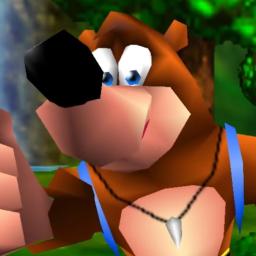 |
by Ian Carlos Campbell on (#70RPE)
Gregg Mayles, the director of Sea of Thieves and designer on Donkey Kong Country, has announced that he's left Rare. News of Mayles' exit was first reported in July 2025 during a rash of layoffs and game cancellations across Xbox Games Studios, but the short poem he shared on X today makes it official.With a 36-year tenure at the studio, Mayles saw its transition from an exclusive Nintendo partner to a Microsoft subsidiary. He helped design games like Battletoads, created Banjo-Kazooie and when studio founders Tim and Chris Stamper left in 2007, stepped up and became Rare's creative director. Mayles also led the team behind Sea of Thieves, one of Rare's modern successes.
|
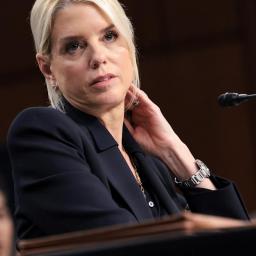 |
on (#70RM2)
Attorney General Pam Bondi posted on X that the Department of Justice contacted Facebook in order to have a group removed that she claimed "was being used to dox and target" US Immigration and Customs Enforcement agents operating in Chicago. We reached out to Meta for confirmation and a representative said, "This Group was removed for violating our policies against coordinated harm," however they did not confirm the name of the group or whether the DOJ was involved in the action.Officers for the immigration agency have reportedly been moving through Chicago with facial coverings, no name tags and sometimes in vehicles with no license plates, although a US District Judge ruled that all ICE agents who are not undercover are required to display visible identification while operating in the Chicagoland area.The Department of Justice has demanded that other tech companies remove content the current administration has deemed critical of its immigration policies and practices. At the start of the month, Apple removed ICEBlock, an app for tracking the movements of immigration agents, from the App Store following similar pressure from Bondi. "Capitulating to an authoritarian regime is never the right move," ICEBlock developer Joshua Aaron said in an interview following the action. "Our mission has always been to protect our neighbors from the terror this administration continues to reign down on the people of this nation."This article originally appeared on Engadget at https://www.engadget.com/meta-removes-facebook-group-for-tracking-ice-agents-after-doj-pressure-203429574.html?src=rss
|
 |
by Ian Carlos Campbell on (#70RHG)
In order to avoid paying billions of dollars in fines for violating the European Union's Digital Markets Act, Google is considering changing how search results are displayed, Reuters reports. EU regulators first took issue with Google's Search and Play Store businesses in March 2025, claiming it favored its own services in search results over third-party options and prevented developers from informing customers of alternative ways of accessing apps.One of regulators main issues with Google Search was that Google appeared to favor results from services like Google Flights or Google Hotels over ones from "vertical search services," providers that specialize in displaying search results from a specific industry, like Expedia or Hotels.com. To avoid fines, Google now wants Search to give VSS businesses equal treatment in results."We will create the opportunity for each VSS to show its own box on Search. A VSS box will be populated with results from that VSS inventory," Google said in a proposal viewed by Reuters. Results from Google's own services will exist with the same formatting alongside, and the winning VSS box will be displayed in search results based on "objective and non-discriminatory criteria." Importantly, search results from actual airlines and car rental companies won't be excluded, they'll also appear in a box "above or below the VSS box depending on the relevance to the user's query."Engadget has asked Google to comment on Reuters'report and to confirm the details of its proposed changes to Google Search. We'll update this article if we hear back.Like Apple, Google faces significant scrutiny from the EU because of its monopolistic control over its various platforms and services. The threat of fines from the DMA has forced Apple to open up its products to third-party app stores, among a host of other changes. Clearly, Google is willing to tweak what once seemed like untouchable pillars of its business to avoid fines, too. Whether these proposed changes will be enough for the regulators remains to be seen, though.This article originally appeared on Engadget at https://www.engadget.com/big-tech/google-reportedly-offers-to-tweak-search-results-to-avoid-eu-fine-193940005.html?src=rss
|
 |
by Andre Revilla on (#70RF0)
Customer service support company 5CA has released a statement contradicting claims by Discord that it was the victim of a hack last month. On October 3, Discord disclosed a data breach that the company says included a small number" of government IDs like driver's licenses and passports, which some users had submitted to verify their ages. Days later the company updated its statement to name 5CA as the target of the hack, which Discord contracts as part of its customer service efforts. It also disclosed that the "small number" of government IDs encompasses roughly 70,000 users."We are aware of media reports naming 5CA as the cause of a data breach involving one of our clients. Contrary to these reports, we can confirm that none of 5CA's systems were involved, and 5CA has not handled any government-issued IDs for this client. All our platforms and systems remain secure, and client data continues to be protected under strict data protection and security controls," the company's statement reads in part. The company goes on to explicitly state "the incident occurred outside of our systems and that 5CA was not hacked."5CA says that a preliminary investigation showed that the incident may have been the result of "human error," though it offers no details as to what exactly that implies. In a recent interview with BleepingComputer, the hackers who claimed responsibility for the breach said they had access to Discord's Zendesk account for 58 hours on September 20. The group claims they gained entry through compromised login credentials belonging to a support agent employed by a third-party company. Discord has not yet responded to the company's claims.Update 2:58 PM ET: Added more context about the breach.This article originally appeared on Engadget at https://www.engadget.com/cybersecurity/the-company-discord-blamed-for-its-recent-breach-says-it-wasnt-hacked-175536278.html?src=rss
|
 |
by Lawrence Bonk on (#70RHH)
Kobo is making a remote control for its line of ereaders. The appropriately-named Kobo Remote costs $30 and will be available to purchase on November 4.A remote control for an ereader may seem silly to some, but avid readers will likely appreciate this accessory. It's basically a wireless page turner, so users can lay in bed and read all day without having to physically hold the device or prop a hand up to push a button every 30 seconds. Kobo is calling it "the ideal reading companion."It has been custom-built for Kobo products and will be available in both black and white, which matches the company's other products. It can integrate with any Kobo ereader with Bluetooth functionality, which includes the Libra 2 and the well-reviewed Clara Colour.In a Canadian winter, we know that sometimes maximum reading comfort means burrowing down in the blankets, tucking yourself in and not emerging until spring," said Rakuten Kobo CEO Michael Tamblyn. The Kobo Remote is the perfect accessory for peak immersive reading; it's an invitation to lounge deeper, multitask smarter and simply enjoy reading without limits, no matter whether your environment is beach or blankets."The remote will be available in multiple regions, including the US, Canada, Europe, Australia, Singapore, Japan and many others. The company says it'll be sharing more details about the remote soon, but we aren't sure what details could be left to share. It's a remote control for an ereader. Maybe it can do one or two unexpected things.This article originally appeared on Engadget at https://www.engadget.com/mobile/tablets/kobo-made-a-remote-control-for-its-ereaders-185010955.html?src=rss
|
 |
on (#70RHJ)
OpenAI announced today that it is creating an advisory council centered on its users' mental and emotional wellness. The Expert Council on Well-being and AI comprises eight researchers and experts on the intersection of technology and mental health. Some of the members were experts that OpenAI consulted as it developed parental controls. Topics of safety and protecting younger users have become more of a talking point for all artificial intelligence companies, including OpenAI, after lawsuits questioned their complicity in multiple cases where teenagers committed suicide after sharing their plans with AI chatbots.This move sounds like a wise addition, but the effectiveness of any advisor hinges on listening to their insights. We've seen other tech companies establish and then utterly ignore their advisory councils; Meta is one of the notable recent examples. And the announcement from OpenAI even acknowledges that its new council has no real power to guide its operations: "We remain responsible for the decisions we make, but we'll continue learning from this council, the Global Physician Network, policymakers, and more, as we build advanced AI systems in ways that support people's well-being." It may become clearer how seriously OpenAI is taking this effort when it starts to disagree with the council, whether the company is genuinely committed to mitigating the serious risks of AI or whether this is a smoke and mirrors attempt to paper over its issues.This article originally appeared on Engadget at https://www.engadget.com/openai-forms-advisory-council-on-wellbeing-and-ai-183815365.html?src=rss
|
 |
by Ian Carlos Campbell on (#70RHK)
OpenAI plans to open the floodgates to more adult uses of ChatGPT starting in December, according to a new post from CEO Sam Altman. The company announced that it would add parental controls and automatic age detection features in September, and it seems like a benefit of sorting out children from adults is an ability to offer more freedom in what ChatGPT can show users."In December, as we roll out age-gating more fully and as part of our 'treat adult users like adults' principle, we will allow even more, like erotica for verified adults," Altman says. Some avid ChatGPT users already regularly manipulate the chatbot to engage in NSFW conversations, but Altman's announcement sounds more like tacit approval from OpenAI that those use-cases are okay.
|
 |
on (#70RHM)
Spotify is taking the video versions of some of its podcasts to another platform entirely: Netflix. Starting in the US in early 2026 (with more markets and shows to follow), Netflix will start offering sports, culture, lifestyle and true crime podcasts that Spotify Studios and The Ringer produce.Nine sports podcasts will be available at the jump, including The Bill Simmons Podcast, The Zach Lowe Show, Fairway Rollin' and The Ringer's F1, fantasy football, NFL and NBA shows. Other video podcasts that are coming to Netflix include The Rewatchables, The Recipe Club, Dissect, Conspiracy Theories and Serial Killers.Netflix sees these podcasts as complementary to its current offerings (The Ringer F1 Show, for instance, will sit neatly alongside Drive to Survive). Of course, for Spotify, this is a way to get more eyeballs and eardrums on its original programming.With TV viewing becoming a bigger priority for YouTube over the last few years, this seems like a way for Netflix to bite back in the battle for consumer attention, given the prevalence of video podcasts on Google's platform. Many people use streaming services for background comfort sound, and turning to podcasts or talk-radio style formats (something Disney+ also offers with The Rich Eisen Show on weekdays) may be a way for them to do that after pulling the plug on cable and broadcast TV.This article originally appeared on Engadget at https://www.engadget.com/entertainment/streaming/some-spotify-video-podcasts-are-coming-to-netflix-180000074.html?src=rss
|
 |
on (#70RF1)
YouTube is bringing a wave of quality of life improvements to its platform. These visual updates and new features will roll out globally starting this week.The main update to YouTube is a redesigned video player that has made the icons and UI elements to obscure less content. This new player design will appear on mobile, web and TV devices. Some users have had access to this feature for about a month, so it may not be brand new to everyone. The seek feature where a viewer can double-tap to skip has also been updated in a way that YouTube says is "more modern and less intrusive" and transitions between tabs have also been upgraded on mobile.For those of you who spend a lot of time in the comments, you'll see a new threaded approach to replies. This update aims "to provide a more focused reading experience within the replies panel." The process of adding videos to playlists and the Watch Later queue has also been simplified and adjusted to be a "smoother and more visual" experience. Finally, some content will start displaying little animations when you hit the like button. The blog post gives music videos and sports videos as examples of where users may start seeing the flashier visual.This article originally appeared on Engadget at https://www.engadget.com/entertainment/youtube/youtube-rolls-out-its-redesigned-video-player-globally-174609883.html?src=rss
|
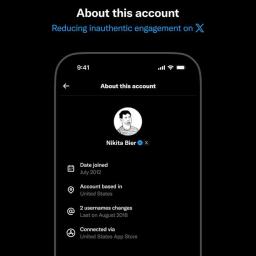 |
on (#70RF2)
X has long been a hotbed for fake accounts, bots and other scammy behavior. Many of those dynamics have been exacerbated by the rise of paid verification, which boosts the visibility of anyone who pays for a subscription. Now, the company is running a small experiment that could help users better identify potentially suspicious accounts.The service is starting to test a new "about this account" feature that will provide details about when an account joined the platform, where the person running it is based, how many times the username has been changed and how the account is connected to X. The feature is a lot like the "page transparency" information on Facebook, which provides similar details about when a given page was created and where the people running it are based."When you read content on X, you should be able to verify its authenticity," X's head of product, Nikita Bier, shared in a post about the change. "This is critical to getting a pulse on important issues happening in the world."If fully rolled out, this type of feature could help people on X understand a lot of common scams and other deceptive behavior on the platform. For example, scammers often change the handle of a recently compromised account in order to trick an account's existing followers. And understanding the location of an account could help users root out people lying about their identity.However, it sounds like it could be some time before the feature is implemented in a way that could be broadly useful. Bier said that initially X will show this info on "a handful of profiles of X team members" - most of whom already have an official "X" badge on their profiles - in order to get feedback on the change.
|
 |
by Lawrence Bonk on (#70RF3)
SteelSeries just released a refresh of its popular Arctis Nova 7 midrange gaming headset. The Nova 7 Gen 2 offers significantly improved battery life, with an increase of around 40 percent when compared to the original version. This translates to 54 hours of use per charge, which is a mighty fine metric. There's quick-charging that can provide six more hours of use in 15 minutes at the outlet.It charges via USB-C and can simultaneously play audio from both a 2.4GHz wireless connection and Bluetooth audio. This means that users can mix and match audio sources, which comes in handy when gaming. The headset connects wirelessly to all major gaming consoles, in addition to PCs and phones.The Arctis Nova 7 Gen 2 integrates with the company's mobile app. This offers more than 200 presets for specific games, all of which adjust the EQ to match what's being played. On PC, the presets will automatically adjust depending on the game.These are headphones intended for gaming, so they also include a noise-cancelling microphone. This little boom mic can be hidden within the headset and disabled when using a standalone microphone.As for aesthetics, the Nova 7 looks a lot like the company's high-end headsets. It's available in three colors, including black, white and magenta. The headset is available to purchase right now and costs $200. It does lack a few features included with its higher-priced cousins, like the swappable battery system and active noise cancellation.This article originally appeared on Engadget at https://www.engadget.com/audio/headphones/steelseries-updated-nova-7-gaming-headset-offers-much-better-battery-life-171435527.html?src=rss
|
 |
by Matt Tate on (#70RBV)
Spotify has introduced a new "managed accounts" feature aimed at younger listeners. Initially piloted last year and launching in seven new markets, including the US, today, it allows parents and guardians with a Spotify Premium Family plan to allocate their children a dedicated profile with their own personalized recommendations and custom playlists.The idea is that the adults can filter out explicit content, limit the playback of certain artists and hide video playback features, including Canvas, should they want to. Users on this profile can't use interactivity features like Messages either.Perhaps most importantly of all for some, a managed account also ensures that your personal Wrapped results at the end of the year aren't dominated by whatever TikTok-viral songs the kids have been obsessively playing on repeat for months - and they won't mess with your Discover Weekly algorithm either. Spotify's 'Exclude from your Taste Profile' feature already offers a way of keeping the nonsense your kids might be listening to away from your own recommended content, but this feels like a cleaner option for families.Standard Spotify Premium features like daylist and the aforementioned Discover Weekly remain available to someone using a managed account, making it a better option for kids becoming interested in music (they may even have gotten hooked on a band you've been listening to in the car) than the Spotify Kids app, which is very much designed for the 'Baby Shark' devotees. It's probably helpful to think of a managed account as a bridge between that and an unrestricted Premium account where all the music in the world is at your fingertips.To set up a managed account, the plan owner has to go into their account settings within the Spotify app and select "Add a Member," followed by selecting "Add a listener aged under 13." The app will provide further instructions from there. As a reminder, a Spotify Premium Family plan is required to set up a managed account. This currently costs $20 per month.This article originally appeared on Engadget at https://www.engadget.com/entertainment/music/spotifys-managed-accounts-will-help-keep-your-kids-from-wrecking-your-music-taste-profile-154406843.html?src=rss
|
 |
by Mariella Moon on (#70R8H)
SpaceX's second-generation Starship vehicle has just made a graceful exit. The company achieved every major objective it set for the super-heavy lift vehicle's 11th flight test, the second-gen Starship's final flight, which launched from Starbase in Texas on October 13. It followed another successful test in August, which saw Starship deploy its payload for the first time ever. Before those two most recent flights, SpaceX suffered a series of failures: Starship exploded during its ascent stage in the company's seventh and eighth tests, and it failed to deploy its payload during its ninth test. Another Starship vehicle blew up on the ground during a routine test while SpaceX was preparing for its 10th flight.All of the vehicle's 33 Raptor engines ignited upon launch, and the stage separation and first-stage ascent went smoothly. The Super Heavy booster splashed down into the ocean as planned, while Starship was able to deploy all its Starlink simulators before re-entering the atmosphere. During its reentry burn, SpaceX intentionally stressed the vehicle to determine the capabilities of its heatshield. And with just a few minutes left to the flight, the vehicle executed a banking maneuver to "mimic the trajectory that future missions returning to Starbase will fly."The company says it will now focus on developing the next generation of Starship and Super Heavy. It has multiple versions of the vehicle and the booster being prepared for tests at the moment, and it expects them to be used for the first Starship orbital flights and operational payload missions.
|
 |
by Valentina Palladino on (#70M8N)
It's safe to say the Nintendo Switch 2 is the game console to get this year, and if you already got your hands on one, you've probably loaded it up with all your old Switch games and new Switch 2 games. If you haven't thought about adding more storage to the console, now's the time to do so. The Switch 2, unfortunately and inconveniently, cannot work with just any old microSD card - it only works with newer microSD Express cards. But now you can actually pick up one of these new cards on sale. This 128GB PNY microSD Express card is 15 percent off and down to $38. Engadget's Jeff Dunn has been testing microSD Express cards since the Switch 2 launched. The best microSD Express card for Switch 2 at the moment is really the one you can most easily afford. While the cards he's tried out so far didn't perform identically in our benchmark tests, the differences in overall performance and load times will be tough for most people to notice. Thankfully, the ones he's tested so far have been good - there isn't a bad one in the bunch, and while the most consistent performer was the SanDisk microSD Express card, you won't really sacrifice by getting a different one. In fact, at least in the case of this deal, you'll be gaining by saving some cash. PNY's card in particular was actually slightly faster than SanDisk's in our testing when it came to moving games from the card back to the Switch 2's internal storage. However, it was a bit slower in writing games to the card itself. That just means you may wait a few extra minutes before you can open Mario Kart World and get to racing, but for most people, the difference will be negligible.This article originally appeared on Engadget at https://www.engadget.com/deals/pick-up-this-nintendo-switch-2-compatible-microsd-express-card-for-less-than-40-134147278.html?src=rss
|
 |
by Lawrence Bonk on (#70R5J)
Therabody just revealed a bunch of new products, including the TheraFace Mask Glo. This MF Doom-looking full-face mask offers quite a different experience from the pre-existing TheraFace Pro. The Pro is essentially a face massager, but the Mask Glo is a giant mask that uses LED lights to "reduce fine lines and wrinkles, firm and tighten skin and even tone and texture."The company promises results in "as little as eight weeks" with daily 12-minute sessions. The mask has been cleared by the FDA and includes 504 medical-grade LEDs to deliver "an effective, full-face treatment." It also doubles as a Halloween mask if you are so inclined. Tis the season. The TheraFace Mask Glo is available to order today and costs $380.The Theragun Mini Plus is a portable version of its popular massage gun, but with one feature missing from the original Mini. This one has heat. It combines "percussive massage with consistent, rapid heat." Therabody says this results in a "benefits 3x faster than percussive massage alone."TherabodyIt features three massage speeds, three heat levels and app-guided routines to target specific muscle groups. The gun is TSA-approved, so bring it on a plane. The Theragun Mini Plus is available today and costs $280.The company also released a new version of the Theragun Prime massage gun, which costs $330, and the Theragun Sense massage gun. That last one features an LCD screen and real-time pressure feedback to make sure people are using it right. It costs $300.This article originally appeared on Engadget at https://www.engadget.com/home/therabody-just-introduced-the-theraface-mask-glo-which-uses-leds-to-reduce-wrinkles-123044315.html?src=rss
|